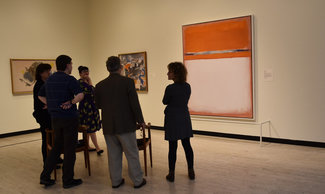|
By Kevin Gray, Arts In Education Coordinator at Fenimore Art Museum, Cooperstown, NY  On November 14th, 2017 I and other museum professionals from central New York attended a lively and inspiring Creativity Incubator provided by NYSCA and the Greater Hudson Heritage Network at Munson-Williams-Proctor Arts Institute. Lia Tamborra, presenter and member of Museum Hack, challenged us to select an artwork in the MWPAI and construct a two to three minute presentation around it that incorporated many of the elements of a Museum Hack tour: an ‘icebreaking’ introduction, a lively and engaging salvo of facts about the artwork and artist in as interactive a manner as possible, and a punchy conclusion that would leave a lasting impression. Each group had about ten minutes to research and plan their talk before delivering. No sweat! Our group (the names of my four or five partners have not lingered in my memory, but it truly was a team effort to put this together) chose the 1951 painting, Number 18 by Mark Rothko. What follows is a transcription of my wild and wooly presentation, recreated to the best of my memory with the conversational tone and sense of last-minute panic retained: “Before we begin our discussion I need everyone to join me in acting class and wake up their inner mime. You’re in a box! (mime the action and encourage others to do the same) Ok, now on the count of three we’re going to break out of our boxes. Ready? 3-2-1, break free!
Look at this painting, creatively titled Number 18, by Mark Rothko. In a bit, I’m going to ask you to reach into another imaginary box, a box of crayons, and give me some names for the colors you see in this painting if they were written on the side of a Crayola crayon. Number 18 here looks like a box, but trust me, it’s so much more. Before we get into it though, let’s deal with the elephant in the room. As we all know, this is the kind of painting that people see hanging in a major art museum and they stand there, scratching their heads and scoffing, “why is this here? It looks like something my child could make!” And it’s totally okay to think that, because Rothko would agree with you! He even tried writing a book about how children’s art and modern painting are related! But while the look of it may seem juvenile at best, the depth of meaning is so much greater. For years Rothko painted in a more representational style, with subjects such as the crucifixion of Jesus and a portrait of Oedipus. Number 18 shown here is one of the first examples of what is now called his ‘multiform’ style, in which he pared down all of his being into a single minimalistic structure. Within these rough-edged blocks of solid colors reside Rothko’s interest in and studies of Freud, Jung, Nietzsche, T.S. Eliot, James Joyce, Greek tragedy, and so much more. You see it, right? Rothko is using pure form, space, and color to cut out the middleman of representation and connect to a more primal trigger of emotion. Knowing this, let’s break out that box of crayons now and give some names to the colors we see here. I’ll riff on Nietzsche and give this example: ‘God Is Dead Orange.’ What names have you come up with? (provide a chance for viewers to give the names they’ve chosen, and give some positive reactions to them) Wonderful! I think Rothko would be proud, although perhaps not, because he had a lot of conflict about his own success. He quickly became disillusioned when his Multiform paintings became popular as hip, cool pieces of decorative art, his rich patrons seemingly missing the deeper meaning of his work entirely. Rothko never lived to see one of his pieces sell for over $86 million or his work decorate the halls of the fictional ad agency in Mad Men, but maybe in some ways that’s actually a good thing.”
1 Comment
Kristin
2/27/2018 11:13:18 am
This was a really inspired and inspiring presentation. It grabbed everyone's attention and drew us in through the miming exercise and the crayon challenge. It helped everyone think and respond differently to this Rothko painting, and encouraged people to speak up about the art work through a means about which they felt comfortable - and perhaps passionate about (crayons).
Reply
Your comment will be posted after it is approved.
Leave a Reply. |
Archives
October 2020
Categories
All
|
 RSS Feed
RSS Feed